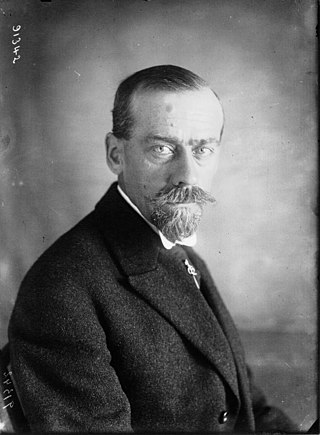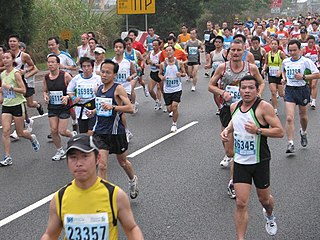
The London Marathon is an annual marathon held in London, England. It is the second-largest annual road race in the UK, after the Great North Run in Newcastle. Founded by athletes Chris Brasher and John Disley in 1981, it is typically held in April, although it moved to October for 2020, 2021, and 2022 due to the COVID-19 pandemic. The largely flat course is set around the River Thames, starting in Blackheath and finishing at The Mall. Hugh Brasher is the current race director and Nick Bitel its chief executive.

The marathon is a long-distance foot race with a distance of 42.195 km, usually run as a road race, but the distance can be covered on trail routes. The marathon can be completed by running or with a run/walk strategy. There are also wheelchair divisions. More than 800 marathons are held throughout the world each year, with the vast majority of competitors being recreational athletes, as larger marathons can have tens of thousands of participants.

The Boston Marathon is an annual marathon race hosted by several cities and towns in greater Boston in eastern Massachusetts, United States. It is traditionally held on Patriots' Day, the third Monday of April. Begun in 1897, the event was inspired by the success of the first marathon competition in the 1896 Summer Olympics. The Boston Marathon is the world's oldest annual marathon and ranks as one of the world's best-known road racing events. It is one of six World Marathon Majors. Its course runs from Hopkinton in southern Middlesex County to Copley Square in Boston.

Road running is the sport of running on a measured course over an established road. This differs from track and field on a regular track and cross country running over natural terrain.

The New York City Marathon, currently branded as the TCS New York City Marathon for sponsorship reasons, is an annual marathon that courses through the five boroughs of New York City. It is the largest marathon in the world, with 53,627 finishers in 2019 and 98,247 applicants for the 2017 race. Along with the Boston Marathon and Chicago Marathon, it is among the pre-eminent long-distance annual running events in the United States and is one of the World Marathon Majors.

Albin Georges Lermusiaux was a French athlete and sport shooter who competed at the 1896 Summer Olympics in Athens.

The Marine Corps Marathon (MCM) is an annual marathon held in Washington, D.C., and Arlington County, Virginia. The mission of the MCM is to promote physical fitness, generate community goodwill, and showcase the organizational skills of the United States Marine Corps.
The World Marathon Majors (WMM) is a championship-style competition for marathon runners that started in 2006. A points-based competition founded on six major marathon races recognised as the most high-profile on the calendar, the series comprises annual races for the cities of Tokyo, Boston, London, Berlin, Chicago and New York. In addition, each edition of the series recognises and includes the results of the major global championship marathon held in that year, usually on a one-off lapped course. These races are the biennial World Athletics Championships Marathon, and the quadrennial Olympic Games Marathon.

The Hong Kong Marathon, sponsored by Standard Chartered Bank, is an annual marathon race held in January or February in Hong Kong. In addition to the full marathon, a 10 km run and a half marathon are also held. Around 70,000 runners take part each year across all events.

Kathrine Virginia Switzer is an American marathon runner, author, and television commentator.

The men's marathon at the 1980 Summer Olympics in Moscow, USSR had an entry list of 76 competitors, with 74 athletes from 40 nations starting and 53 runners finishing the race held on Friday 1 August 1980. The maximum number of athletes per nation had been set at 3 since the 1930 Olympic Congress. The event was won by Waldemar Cierpinski of East Germany, the second man to successfully defend Olympic gold in the marathon. Both the Netherlands and the Soviet Union won their first men's Olympic marathon medals.
The logos and uniforms of the Boston Red Sox have gone through a limited number of changes throughout the history of the team.

The Mastercard New York Mini 10K is an annual 10-kilometer road running competition for women that takes place in Central Park, New York City, in the United States. The race has been organised by New York Road Runners since 1972. The competition has both an elite-level race and a fun run, both of which accounted for a total of 5189 finishers in 2010.
The running boom of the 1970s occurred in high- and middle-income countries. It was particularly pronounced in the United States and occurred in other countries including the United Kingdom and other European countries, Australia and New Zealand.

John Duncan Semple was a Scottish-American runner, physical therapist, trainer, and sports official. In 1967, as a race official for the Boston Marathon, he attempted to stop the 20-year-old marathon runner Kathrine Switzer from continuing to run and knocked down her coach when he tried to protect her. Switzer was officially entered in the race in accordance with the Boston Marathon's rule book, which at that time made no mention of sex. Semple subsequently claimed that amateur rules banned women racing for more than 1.5 miles (2.4 km). He subsequently oversaw implementation of qualifying times in 1970 and, in response to lobbying and rule changes by the Amateur Athletic Union (AAU), the implementation of a separate women's race in 1972.
Spirit of the Marathon II is a 2013 American documentary film directed by Jon Dunham. The film is the sequel to the 2007 film Spirit of the Marathon, and chronicles the journey seven marathon runners experience leading up to competing in the 2012 Rome Marathon. It received a one-night limited release on over 600 screens in the United States on June 12, 2013.

The 2017 Boston Marathon was the 121st running of the Boston Athletic Association's mass-participation marathon. It took place on Monday, April 17. Geoffrey Kirui won the men's race in 2:09:37 and Edna Kiplagat won the women's race in 2:21:52.
The Avon International Marathon was an annual women's marathon event that was held at various locations from 1978 to 1984. Sponsored and organised by Avon Products, a beauty and household goods company, it was the longest distance race within the Avon International Women's Running Circuit, which was created with the aim of promoting elite and grassroots road running for women. The circuit was headed by former runner Kathrine Switzer, whose efforts had led to the formal acceptance of women at the Boston Marathon.
The 2021 British Athletics Marathon and 20 km Walk Trial was held on 26 March 2021 as a trial event for British athletes to qualify for the delayed 2020 Summer Olympics in Tokyo. It was the first time since 1980 that a dedicated marathon trial event was held, and the courses consisted of multiple laps around Kew Gardens in London.
William Thomas Cloney was an American athletics administrator who was the race director of the Boston Marathon from 1946 to 1982 and president of the Boston Athletic Association from 1964 to 1982.


























